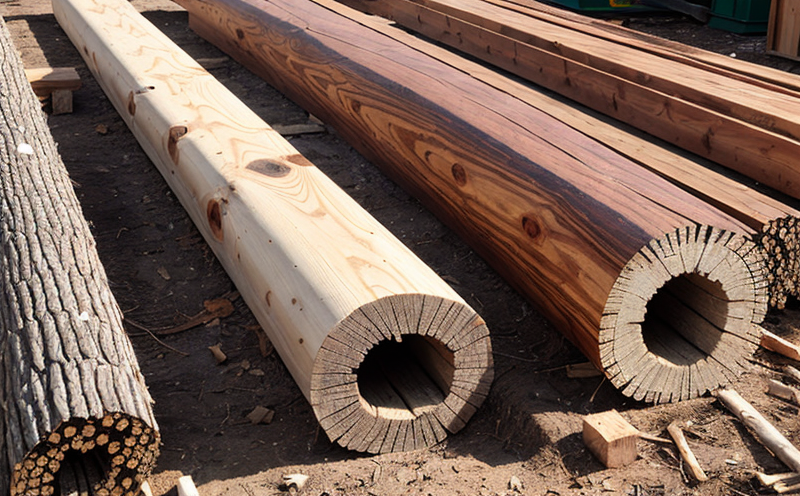Preservative Penetration Depth Testing
The process of preservative penetration depth testing is crucial in ensuring that wood products used in agriculture and forestry are properly treated with preservatives to resist decay, insect infestation, and fungal growth. This service involves the application of preservatives into wooden materials and subsequent quantification of their distribution within the material's structure. The aim is to verify compliance with regulatory standards and quality assurance requirements.
The testing procedure typically begins with selecting an appropriate specimen that represents the wood type intended for agricultural use, such as fence posts or crossbeams in forestry applications. Once chosen, the sample undergoes preservative treatment according to specified protocols. After treating, the samples are air-dried under controlled conditions to prevent post-treatment contamination.
Once dried, the specimens are subjected to various analytical techniques designed specifically for quantifying preservative content across different depths of wood. Common methods include gravimetric analysis, extraction tests using solvents like methanol or acetone, and more advanced spectroscopic analyses such as Near-Infrared Spectroscopy (NIRS) and Raman Spectroscopy.
Gravimetric analysis involves measuring the weight loss after treating with a solvent capable of extracting the preservatives from the wood. Extraction tests provide quantitative data on how much preservative remains in each depth layer, thereby indicating effective penetration rates throughout the entire cross-section. NIRS and Raman Spectroscopy offer non-destructive alternatives that can map out preservative distribution across varying depths without causing damage to the sample.
Acceptance criteria for pass/fail results depend on the specific regulatory framework governing wood products in agriculture or forestry. For instance, according to ISO 6384-1:2015, standards dictate minimum penetration depths at certain locations within the wood specimen based on its thickness and intended application.
This testing service plays a vital role not only for manufacturers of treated wood but also for regulatory bodies responsible for enforcing safety and quality norms. It helps maintain consistent product performance across batches by providing detailed insights into how well preservatives have penetrated the wood matrix during production processes.
Why It Matters
The importance of preservative penetration depth testing cannot be overstated, especially given the critical role that wood plays in various agricultural and forestry applications. Proper preservation ensures longevity and reliability while minimizing environmental impact. By ensuring consistent treatment across all parts of the wooden structure, this service helps prevent premature failure due to biological attacks.
From an economic perspective, effective preservative penetration reduces maintenance costs associated with replacing damaged components and enhances overall asset value over time. For procurement departments, knowing exactly where preservatives have reached within a piece of wood provides assurance that they will perform as expected under field conditions.
In terms of environmental responsibility, thorough testing ensures that no excess chemicals are wasted during production while still achieving sufficient protection against natural elements. This aligns with broader sustainability goals by promoting efficient resource utilization and reducing waste generation throughout the supply chain.
Applied Standards
The methodology employed in preservative penetration depth testing adheres closely to internationally recognized standards such as ISO 6384-1:2015, which specifies procedures for determining the amount of wood preservatives present after treatment. This standard outlines detailed steps for sample preparation, treatment application, drying methods, and analytical techniques.
For gravimetric analysis, ISO 6797:2018 provides guidelines on using solvents to extract preservatives from wood samples. It details specific concentrations of methanol or acetone solutions suitable for different types of wood preservatives. Additionally, ASTM D5434-03 offers alternative approaches focusing on colorimetric detection systems.
Near-Infrared Spectroscopy (NIRS) and Raman Spectroscopy follow their respective standards set by ISO/IEC 17025:2017 for calibration requirements and accuracy expectations. These spectroscopic techniques allow non-destructive evaluation of preservative distribution without altering the sample's integrity.
Use Cases and Application Examples
- Fence Post Treatment: Ensuring that preservatives penetrate sufficiently deep into fence posts prevents early rotting caused by moisture absorption. This enhances their durability and extends service life in outdoor environments.
- Crossbeam Preservation: In forestry applications, preserving crossbeams used for construction purposes ensures they remain stable against decay and insect damage during prolonged exposure to weather conditions.
- Pole Treatment: For utility poles supporting overhead power lines or telecommunications infrastructure, effective preservative penetration guarantees sustained structural integrity despite long-term immersion in soil environments.





